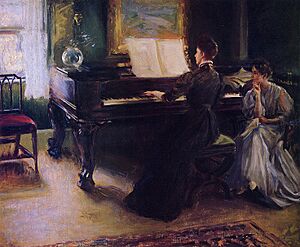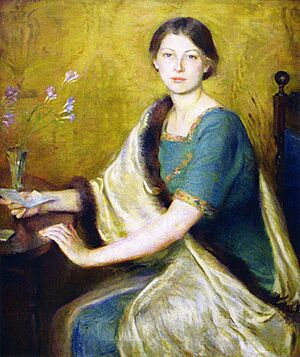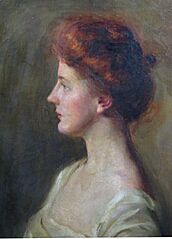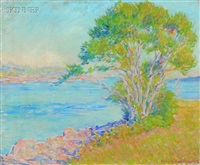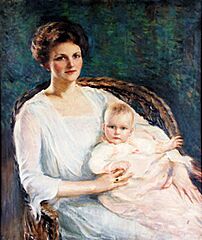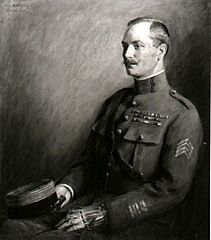Mary Brewster Hazelton facts for kids
Quick facts for kids
Mary Brewster Hazelton
|
|
|---|---|
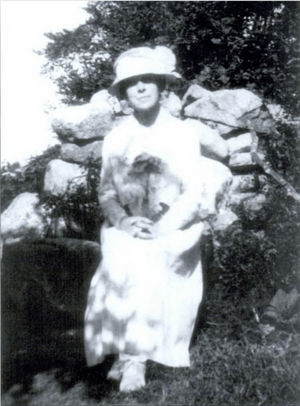 |
|
| Born | November 23, 1868 |
| Died | September 13, 1953 (aged 84) |
| Resting place | Woodlawn Cemetery, Wellesley, Massachusetts |
| Known for | Painting portraits |
| Awards |
|
Mary Brewster Hazelton (born November 23, 1868 – died September 13, 1953) was an American artist known for her amazing portrait paintings. She studied at the School of the Museum of Fine Arts, Boston, where she later became a teacher.
Mary Hazelton made history in 1896. She was the first woman to win the Hallgarten Prize from the National Academy of Design. This award was open to both men and women. Her beautiful portraits can be found in important places like the Massachusetts State House and Harvard University. She was also a founding member of the Wellesley Society of Artists. She lived most of her life with her sisters in their family home in Wellesley, Massachusetts.
Contents
Early Life and Family
Mary Brewster Hazelton was born on November 23, 1868, in Milton, Massachusetts. Her father, Dr. Isaac Hills Hazelton, was a doctor who served in the United States Navy during the American Civil War. He was known for new ideas in healthcare.
Mary had a brother, Isaac, and two sisters, Olivia and Margaret. Olivia became an expert in music education for young children. Isaac was a commercial artist, and Margaret took care of their home. In 1873, Mary's family moved to Wellesley, Massachusetts.
Mary started creating art in the 1880s. She often signed her early works with her nickname, "Daisy." She graduated from Wellesley High School in 1886. Mary and her two sisters lived together in their family home in Wellesley for their entire adult lives.
Becoming an Artist: Her Education
Mary Hazelton went to the School of the Museum of Fine Arts, Boston (MFAB). She studied with famous artists like Edmund C. Tarbell. She finished her studies at MFAB in 1892.
After graduating, she became an assistant drawing instructor. Her teachers, Edmund Tarbell and Frank Weston Benson, were well-known Impressionist painters from Boston.
In 1899, Mary won the Paige Traveling Scholarship from the Museum of Fine Arts, Boston. She was the first person to receive this special scholarship! It gave her $800 each year for two years. This allowed her to study art in other countries. She traveled to Paris, Spain, England, the Netherlands, and Italy.
Her Unique Painting Style
Mary Hazelton was one of many talented women artists who studied at the School of the Museum of Fine Arts in the late 1800s. At that time, women artists often didn't get credit for their own unique styles. People sometimes thought their skills came only from their male teachers.
However, Mary Hazelton's paintings showed her own special talent. She painted in a creative and bold way. Her style often included a "loose Impressionist manner." This means her paintings looked like they were made with quick, visible brushstrokes, capturing light and movement.
Her technical skills were amazing, especially how she put together a painting (composition) and how she used light. A great example is her painting Two Sisters at the Piano, made around 1894. It shows her ability to capture a moment with beautiful light.
Her Career and Achievements
Mary Hazelton achieved many important things in her career. In 1896, she won the First Hallgarten Prize for her oil painting In a Studio. This was a big deal because it was the first time a woman won an award that was open to both men and women in the United States. Her painting was chosen as the best oil painting by an artist under 35 that year.
She also won an Honorable Mention at the Pan-American Exposition in Buffalo, New York, in 1901. In 1915, she won a bronze medal at the Panama–Pacific International Exposition in San Francisco, California. She showed her paintings The Letter and Reverie there. She also won a prize for The Letter in Newport, Rhode Island, in 1916.
Her Boston Studio
In 1904, Mary Hazelton had a studio in Boston. A big fire destroyed many artists' works, including hers. After the fire, a group of artists planned a new building called Fenway Studios. Mary was one of the first artists to get a studio there. She worked from her studio at Fenway from 1906 to 1940.
Church Murals and War Efforts
In 1912, Mary was asked to paint large wall murals for the Wellesley Hills First Congregational Church. She was a member of this church. One mural shows four important ideas: truth, charity, justice, and faith. These are shown as eight-foot-tall figures of three women and one man. For example, the man holds a sword and scales to represent justice. She also painted murals of the Four Evangelists and the Trinity.
During World War I, Mary Hazelton helped her country. She designed a poster for the Liberty Loan campaign. This campaign encouraged people to buy bonds to help pay for the war. Her poster used her painting called Victory's Record.
Famous artist John Singer Sargent once said that Mary Hazelton was "one of the foremost portrait painters of her time." This shows how highly respected she was in the art world.
Art Organizations
Mary Hazelton was very active in the art community. She helped start the Wellesley Society of Artists and was its treasurer. She was also a founding member of The Guild of Boston Artists. She was an early member of the Copley Society, the Concord Art Association, and the American Federation of Arts.
Later Life and Legacy
In 1952, Mary Hazelton had a stroke. This made it hard for her to paint with her right hand, so she learned to paint with her left hand. She passed away on September 13, 1953, at the Newton-Wellesley Hospital.
After her death, the Wellesley Historical Society began collecting her paintings in 1965. They now have about 50 of her works. They also keep her sketchbooks, diaries, letters, and photographs. These items help us learn more about her life and amazing art.
Collections
Mary Brewster Hazelton's paintings are held in several important collections:
- Harvard Club of Boston, Harvard University
- John Adams, 1914
- Harvard University, Cambridge, Massachusetts
- Paul Jean Louis Azan, 1918
- George Cheyne Shattuck, 1910
- Dr. John Warren
- Massachusetts General Hospital
- Massachusetts State House, Boston, Massachusetts
- William Stoughton, 1924
- Peabody Essex Museum, Salem, Massachusetts
- Francis Henry Appleton
- Wellesley Historical Society, Massachusetts (some of their 50 paintings):
- Seldon L. Brown
- Ralph Coburn
- Herbert M. Hazelton
- Margaret Page Hazelton
- Mrs. John Oldham
Gallery
- Paintings by Mary Brewster Hazelton



